Operating a call center without routinely evaluating call center KPIs or call center metrics is similar to driving a car with an opaque windshield– meaning, performing operations without knowing whether you are moving forward or backward toward call center efficiency.
However, regularly evaluating call center metrics will provide you with valuable insights into your performance and enable you to make necessary changes in strategy on time, averting further damage.
Not only do call center KPI metrics provide vital insights, but they also allow you to minimize resource waste and reallocate resources towards critical operations. Overall, monitoring call center KPIs regularly is an essential duty that no organization should overlook or avoid.
But what are the most critical call center key performance indicators, and how should they be calculated? Well, this blog is the perfect response to that question. In this blog, we will look at the top 25 best call center KPIs and Metrics that you must track in order to analyze and improve performance.
Let’s get started without much ado!
25 Top Call Center KPIs & Agent Productivity Metrics
1. Average Handle Time (AHT)
The average handle time (AHT) refers to the amount of time a call center agent takes to complete one conversation or transaction. The handling time for one call is the time taken from the call initiation to disconnecting the call.
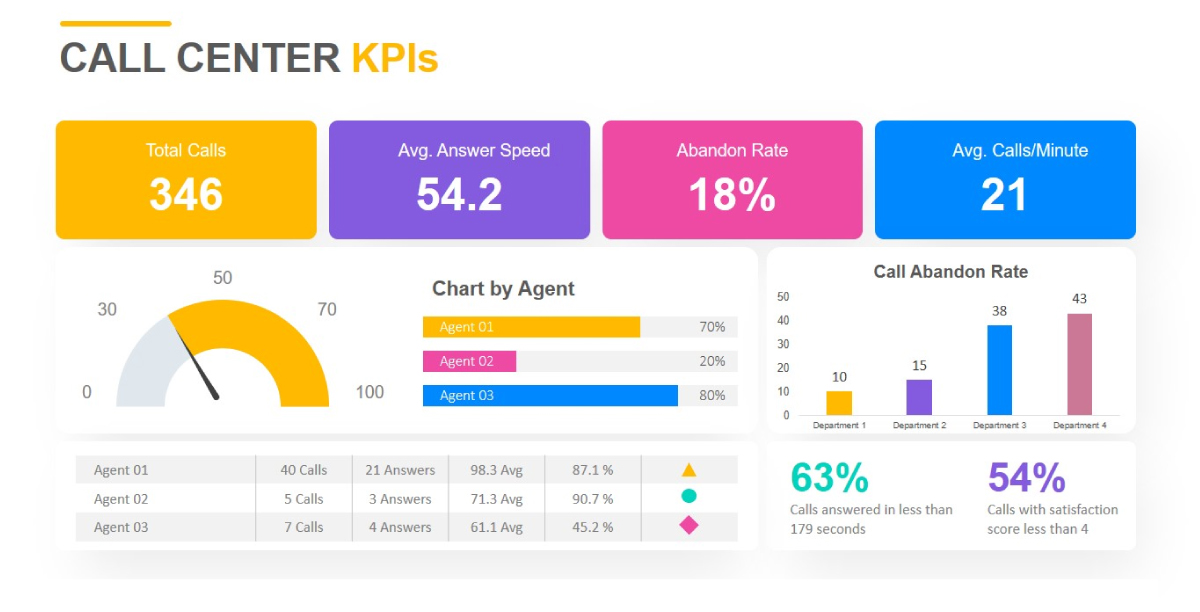
( Source: powerslides )
AHT is considered as one of the crucial call center KPIs when making decisions on contact center staffing levels. For example, when you know how long a call is likely to last, you can schedule calls to agents accordingly. This ensures better workload management and prevents the agents from getting overwhelmed.
How to Calculate Average Handle Time?– You can calculate an agent’s AHT by measuring their total on-call time and dividing it by the total number of calls made in a specified period.
2. First Response Time (FRT)
Data from Forrester shows 77% of customers will stick with a company that values their time. Hence, the first-response time (FRT) is one of the top call center KPIs or the call center metrics you should measure. It helps you determine the time each agent takes to pick up an incoming call.
Since no one likes to be put on hold, a high FRT can indicate poor customer experience. In fact, 35% of callers will abandon a call if their call isn’t answered within a minute. This figure increases to 66% after three minutes.
How to Calculate First Response Time?– To measure FRT, add the time an agent takes to answer each call and divide it by the total calls they take in a particular time period.
3. First Call Resolution (FCR)
When an agent resolves a customer’s query on the first call, it’s called first call resolution (FCR) or First Contact Resolution. It’s another essential metric to measure agent efficiency and performance, and in a support-based call center, FCR is one of the Call Center KPIs to measure agent’s performance.
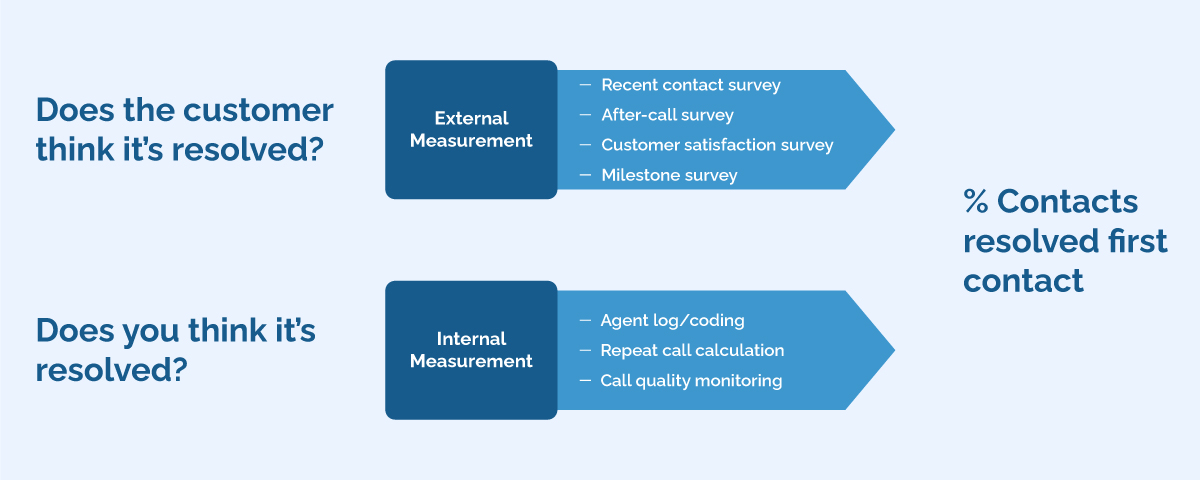
When you solve customer queries on the very first call, they’re more likely to be happy with your service level and share positive feedback. The standard benchmark for FCR is 70-75%.
How to Calculate First Call Resolution Rate?– You can measure FCR by determining the number of queries an agent has resolved on the first call in a provided period.
4. Average After Call Work (ACW)/ Wrap Up Time
The job of a contact center representative involves more than just making calls. The agents need to manage other tasks like updating CRM, maintaining spreadsheets, sending emails, and more. The Average After Call Work Time (ACW) allows you to measure the amount of time an agent spends on work other than answering calls. Along with other call center metrics, ACW should also be measured on a regular basis.
To ensure contact center efficiency, managers should ensure that their agents’ ACW isn’t too high. An effective way to reduce ACW is to finish other tasks while talking to the customer instead of doing them after ending the call.
How to Calculate After Call Work Time?– ACW is the opposite of occupancy rate. To measure ACW, calculate the total time an agent spends on activities other than live calling and divide it by the total working hours in a day.
5. Transfer Rate
The 5th one on our list of “25 Best Call Center Metrics To Measure Performance” is the Transfer rate. It denotes the number of incoming calls an agent transfers to another agent, most likely a senior or an agent in another department, to resolve a customer’s query.
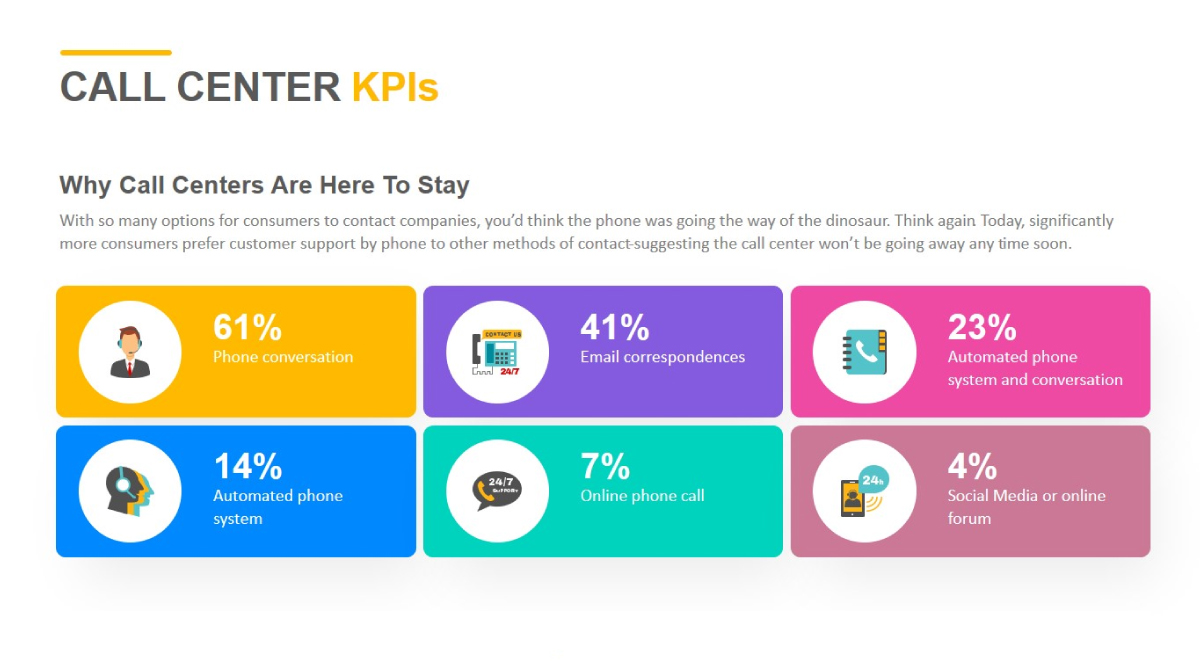
( Source: powerslides )
In some cases, call reps may need to forward the call to someone else for better query resolution. But an alarmingly high transfer rate can indicate an agent’s inability to resolve customer queries.
How to Calculate Transfer Rate: Determine the total number of calls an agent has transferred and divide it by the total calls he has taken in a specified time period. Multiply the outcome by 100 to get percentage data.
6. Idle Time
Call center agents are humans too, and they need rest once in a while. However, spending too much time doing nothing can be a major indicator of an unproductive work environment. The idle time– one of the vital call center KPIs, allows you to measure the amount of time an agent spends doing things that are not related to work.
This could include lunchtime, coffee breaks, gossiping with colleagues, or just loitering around the office.
How to Calculate Idle Time?– Calculate the time an agent spends doing non-work-related tasks. This includes lunchtime, coffee breaks, etc. Then, divide the result by total working hours in a day to get the idle time.
7. Average Hold Time
Because of automated or power dialers, the customers often need to hold the call for a longer time, which sometimes results in call drops or call abandonment. Longer hold times are also possible for technical reasons or because the agent is seeking a solution or assistance from a senior.

(Source: cxceed)
Therefore, the proper and in-depth analysis of this average hold time is essential to study, as it might reduce overall profitability. Make sure you calculate AHT, along with other call center metrics, on a regular basis.
How to Calculate Average Hold Time?– The AHT is calculated by adding all incoming customer calls and message hold times and dividing that total by the number of inbound customer calls answered by the agent or interactive voice response (IVR) system.
8. Abandon Call Rate
In inbound or outbound call centers, when the dialer hangs up the call or when the call gets disconnected before getting connected to the live agent, such calls are termed as abandoned calls. It is one of the critical call center KPIs that needs to be tracked regularly.
Tracking the abandoned call rate metric depicts the percentage of callers who hang up the phone or abandon the queue. Ideally, the abandoned calls should be as low as possible.
How To Calculate Abandon Call Rate?– To calculate the abandoned call rate, one needs to divide the total number of abandoned calls by the total number of calls. Please note you need to exclude all such calls from the calculation that get disconnected within the first 5 seconds of the call.
9. Dropped-Call Rate
The dropped-call rate is among the critical call center metrics used by contact centers to monitor network performance. The dropped-call rate (DCR) is the percentage of phone calls that were cut off due to technical reasons before the communicating parties had finished their conversation.

( Source: scorebuddyqa )
The cause might be anything from inadequate coverage to poor signal quality to network congestion and outages.
How to Measure Dropped-Call Rate?– To know the dropped call rate, divide the total number of calls dropped by the total number of calls received, multiplied by 100.
10. Average Sales Per Agent
Sales per agent (SPA) is also one of the essential call center KPIs that’ll help you measure an agent’s performance or professional competence. You can use this metric to identify your best performers, tweak sales targets, and determine the scope for training and improvement.
Along with SPA, you also need to measure revenue metrics as well. It could either be revenue per time period (Day, Week, or Month) or revenue per successful call. Pairing SPA with revenue generated will help you get an accurate insight into an agent’s performance.
How to Calculate Average Sales Per Agent?– You can measure average SPA by finding the total amount of sales that an agent has made within a defined period.
11. Cost Per Call
Along with other call center metrics, the call center should calculate the Cost per Call metric to determine how much each individual call costs the organization. This statistic helps establish whether there is a benefit to acquiring contacts or if acquisition costs are outrageously costly. The statistic also helps in examining how efficient the call center is.
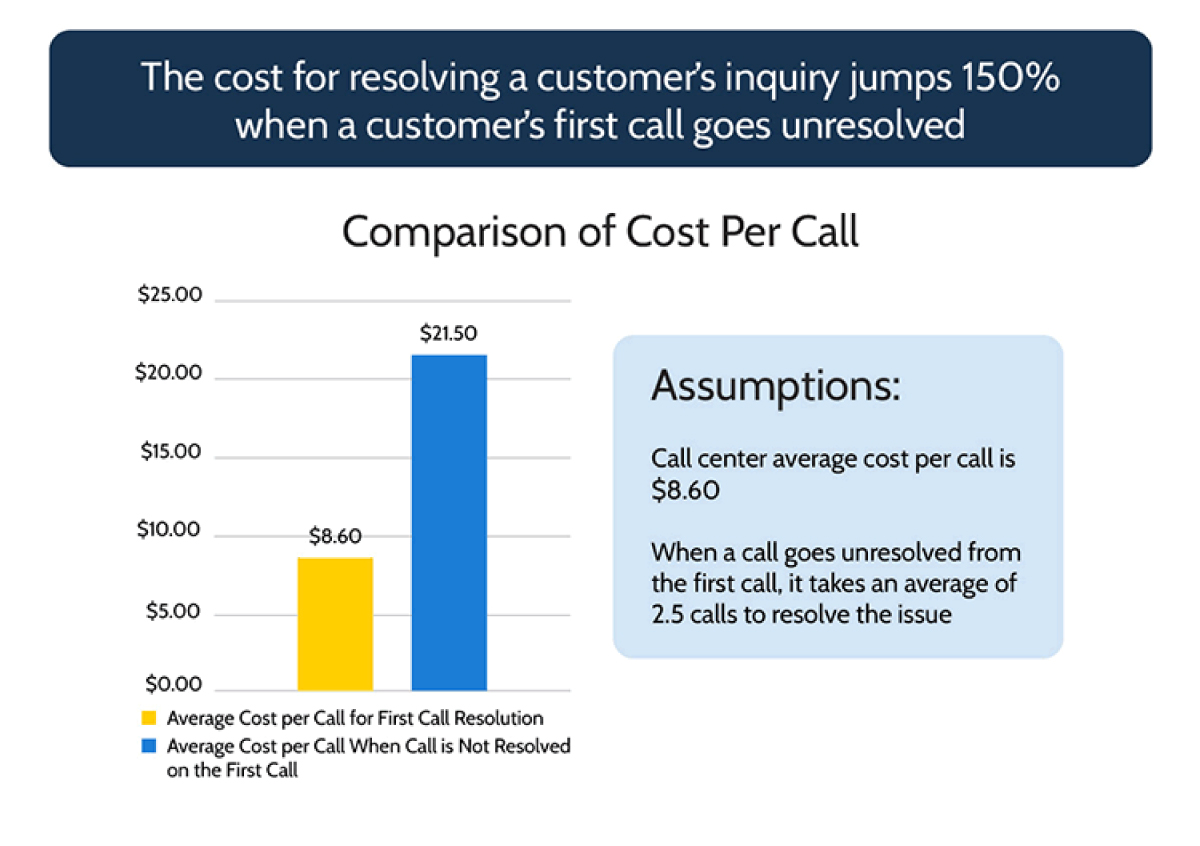
( Source: sqmgroup )
How To Calculate Cost Per Call?–Calculating the Cost-Per-Call necessitates gathering all expenses, including operational, maintenance, and licensing fees, among others. Then, divide the total cost by the total number of calls you attended or made during the same period.
12. Peak Hour Traffic (PHT)
The next matric on our list of “25 Best Call Center KPIs To Measure Performance” is Peak Hour Traffic (PHT)– a KPI in BPO that describes when the call center experiences the most call traffic or call volume during the day. This enables organizations to plan ahead of time and schedule enough call agents to handle the high volume of calls during that specific time period.
How to Measure Peak Hour Traffic?– To calculate PHT, you will not need any method or formula. All you have to do is track the call volume every day for a few days to figure out what time of day you generally have the highest call traffic.
13. Customer Satisfaction Rate (CSAT)
A customer satisfaction (CSAT) rate is also one of the key marketing as well as call center KPIs that measures how satisfied a customer is with the company’s service or product. The resulting output assists organizations in understanding how well their products or services are doing and what needs to be done to improve the customer satisfaction.

( Source: netigate )
In other words, it measures customer satisfaction while also providing decision-makers with quantitative and qualitative actionable data at crucial points of interaction.
How to Calculate Customer Satisfaction Rate?– Unlike other call center metrics, CSAT can be calculated in several ways, including by feedback surveys, questionnaires, data analysis, and so on. Choose the method that best meets your needs.
14. Time Lost Due To Technical Issues
Technology doesn’t always work the way we want it to, right? As a call center manager, you need to understand the amount of downtime that has occurred as a result of technical issues such as system faults, server issues, power outages, internet blackouts, and other difficulties.
This, one of the essential contact center KPIs, gives insight into total downtime due to technical problems and helps the organization find how reliable their system is.
How to Calculate Time Lost Due To Technical Glitches?– There is no exact formula for calculating lost time due to technical issues. All you have to do is add up the total amount of time the system remains idle during working hours due to technical reasons.
15. Agent Productivity
Agent Productivity is among the vital call center KPIs that gives managers or the organization a view into the total share of time call agents engage in calls to or work on call-related work. While monitored alongside a target value, this call center metric helps managers see how productive their team is in relation to set goals.

( Source: newswire )
Furthermore, management takes the appropriate steps to boost agent productivity or adjust process workflow based on the results.
How to Calculate Agent Productivity?– To calculate the agent productivity, divide the Total Input by Total Output and multiply the result by 100.
16. Revenue Per Successful Call
In addition to the 15 call center metrics listed above, the call center should also calculate the Revenue per Successful Call metric to let your team know just how much revenue they are bringing into the company from a single successful call.
This metric helps managers plan expected revenue with set targets and current progress while also giving them a view into how valuable an effective call can be for the team.
How to Calculate Revenue Per Successful Call?– You can calculate the Revenue Per Call (RPC) by dividing the total sale amount by the number of successful calls made during the specified period.
17. Cost Per Acquisition (CPA)
We mean leads when we say “acquisition.” CPA is considered as one of the vital call center KPIs that calculates the total cost of acquiring one paying customer on a campaign or channel level. For each outbound call center, this cost analysis is a critical statistic.
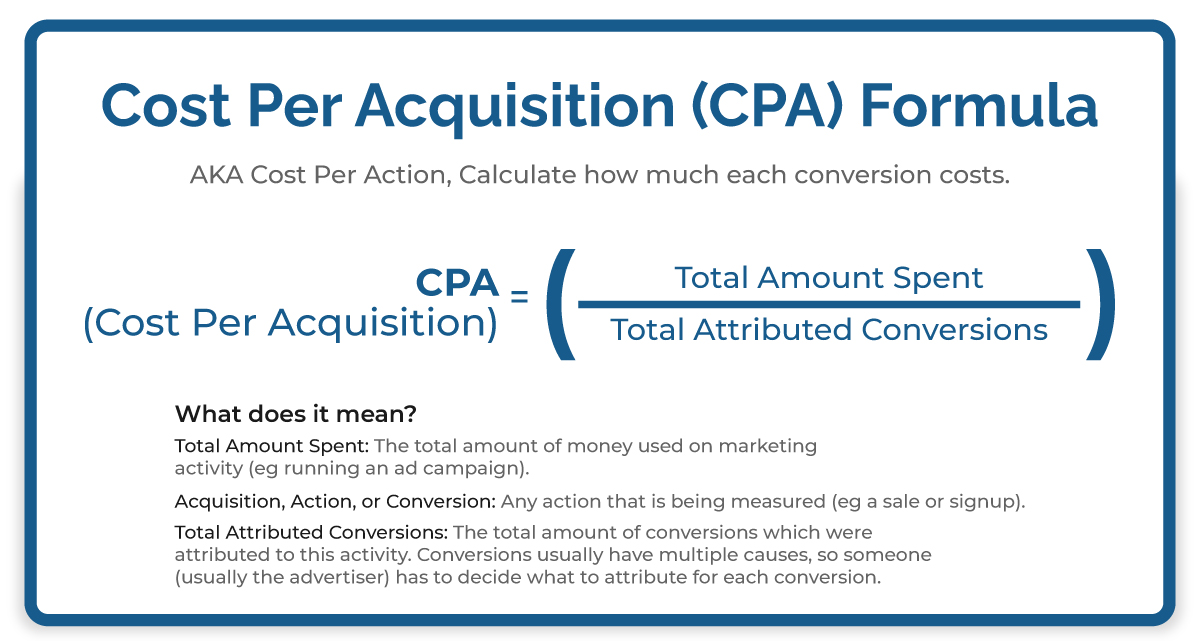
( Source: theonlineadvertisingguide )
The acquisition might be any specific action, such as a sale, a click, a form submission, a demo booking, and so on.
How to Calculate Cost Per Acquisition?– CPA can be calculated by dividing total attributed conversions by the total amount spent.
18. Connect Rate
The number of attempts made by a call center agent or a salesperson to connect with a lead or the intended target is referred to as the connect rate. It is one of the essential call center KPIs for determining the effectiveness of the client acquisition process.
A higher connection rate demonstrates that the agents are competent and the workflow is well-designed. On the other hand, a lower contact rate indicates that there is room for improvement.
How To Calculate Connection Rate?– To calculate the connection rate, divide the number of calls answered by the number of calls placed.
19. Average Age of Query
The Average Age of Query (AAQ) is among the important call center performance metrics that should be measured in addition to the other call center KPIs listed above. You can use the AAQ to determine how long each query remained active.
In other words, it is the average amount of time that each case remains open or the amount of time required for resolution. The average age of the query should ideally be as low as possible. To ensure optimum performance, you must calculate AAQ on a regular basis along with other contact center KPIs.
How to Calculate Average Age of Query?– You can measure AAQ by determining the average time an agent takes to resolve a query and divide it by the total queries resolved in a given time period.
20. Net Promoter Score (NPS)
The NPS is one of the most popular call center KPIs used by call centers and customer support teams to measure a customer’s experience and loyalty. The NPS score depends primarily on the question as to how often a customer would recommend a company to their friends or family.

( Source: retently )
The scoring in NPS tools happens on a 10-point scale, with 0 being the worse and ten being the best.
How to Calculate NPS?– Add up total responses (1 to 10) from all customers and divide it by the total number of responses in specified time duration.
21. Occupancy Rate
Another crucial call center metric is the occupancy rate. It is the time agents spend on live calls. In other words, it is the percentage of time that an agent actually spends handling incoming calls against the available or idle time, which is determined by dividing workload hours by staff hours.
If your agents have low occupancy rates, the chances are that they’re spending most of their time on unproductive tasks. So make sure, in addition to other call center metrics, you keep a keen eye on occupancy rate as well.
How to Calculate Occupancy Rate?– Calculate the total time an agent stays on live calls and divide it by the total working hours in a day. You can also multiply the outcome by 100 to get percentage data.
22. Lead Conversion Rate
The lead conversion rate metrics, also known as the lead-to-conversion rate, are the number of leads generated by the organization that results in a successful sale. This metric assesses the efficiency of the company’s sales funnel and helps them to improve conversion rate.

( Source: trewmarketing )
A poor conversion rate indicates that the organization incurs extra costs to convert a lead into a buyer. However, keep in mind that a 2-5 percent conversion rate is generally regarded as a decent one.
How to Calculate Conversion Rate?– To calculate the lead conversion rate, divide the number of leads converted to opportunities or customers in a given period by the total number of leads targeted.
23. Average Talk Time
The 23rd matric on our list of “25 Best Contact Center KPIs & Metrics To Measure Performance” is Average Talk Time. ATT is the amount of time a call center agent spends interacting with customers to address their concerns or help them through a technical issue.
This call center metric is sometimes mixed up with Average Handling Time (AHT). However, unlike AHT, ATT does not cover time on hold, after-work time, and so forth. Instead, it just covers the time spent interacting with the agent.
How to Calculate Average Talk Time?– To calculate total talk time, all you have to do is to add the total hours that agents spend interacting with customers divided by the number of calls they handle.
24. Calls Per Agent
Calls per agent matric reflect how active a particular sales agent is on the calls. Therefore, in order to increase the rate of calls per agent or the call center’s productivity, we should appropriately monitor the agents’ performance.
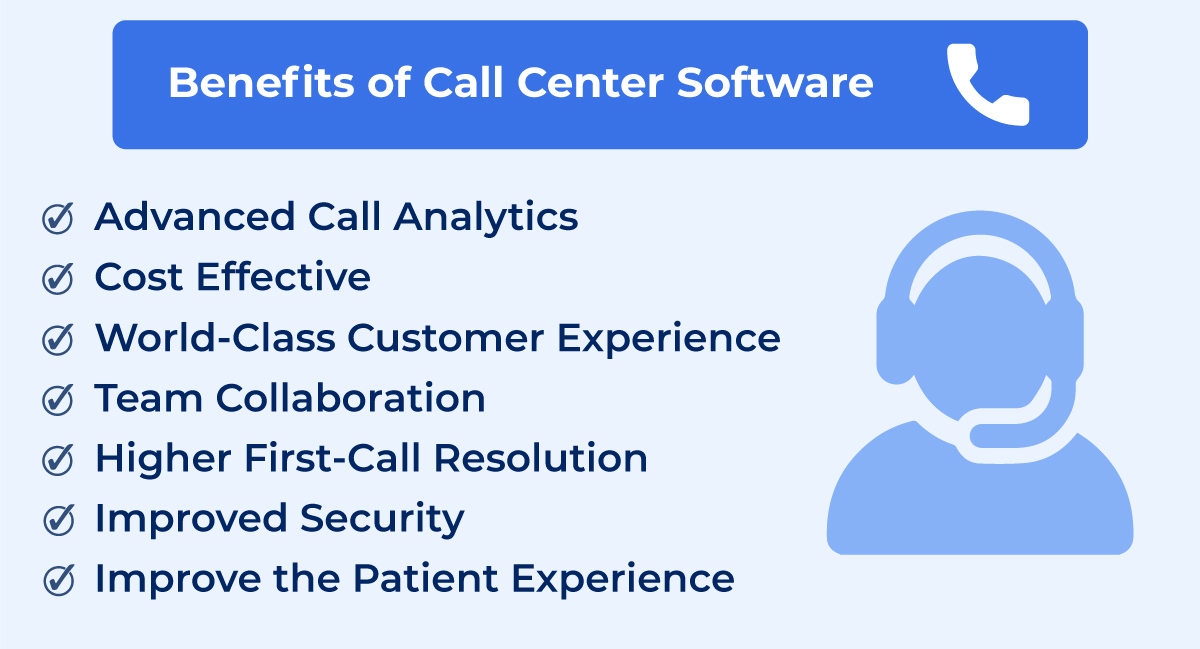
Other ways for improving calls per agent include automating workflows, providing essential training, and providing agents with advanced communication channels and call center software.
How to Calculate Calls Per Agent?– To compute calls per agent, add the total number of calls handled by the department and divide it by the total number of agents. This call center metric also allows you to determine whether or not your agents are overburdened.
25. Average Speed of Answer (ASA)
The last guest on the list of “25 Best Call Center Metrics To Measure Performance” is Average Speed of Answer. It is the average amount of time a call center agent takes to answer a customer’s phone call. This call center metric can help uncover issues in the process, such as whether or not employees are competent enough, whether or not the call center is understaffed, and so on.
The optimal ASA is 28 seconds. That is, a call should be answered within 28 seconds of being received.
How to Calculate Average Speed of Answer?– ASA is easily calculated by dividing the overall wait time for answered calls by the total number of calls answered. The purpose of ASA is to determine whether customers are waiting in line for too long.
So, these are the top 25 call center metrics examples that you should monitor and calculate on a regular basis. A thorough analysis of all of these 25 call center KPI examples will guarantee that your call center operations always stay on track and you reap the maximum benefits, besides improving customer satisfaction score.
The Bottom Line
Call center metrics are essential to calculate since they assess the overall competency and performance of call center agents as well as the team as a whole. Based on the call center KPIs, management can make the appropriate decisions to improve performance and meet organizational goals. Therefore, if you run a call center or are planning to start one, in addition to investing in call center software, you should keep a close eye on all of the call center metrics and KPIs listed above.

Subscribe to our newsletter & never miss our latest news and promotions.









